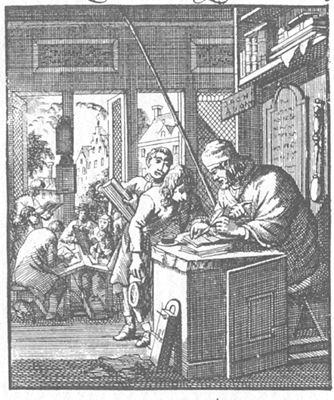
This was a part time, paid position. It is sometimes referred to as Teacher of the Dutch School in Stokes.
The school was in session seasonally.
In the beginning, the children were taught to read and write by a lay minister known as a voorleser or a siekentrooster, using the Heidelberg Catechism as his teaching tool. Instruction was supervised by the Reformed Dutch Church, whose aim was to have children learn the beliefs of the Church by learning and memorizing the Catechism. A schoolmaster, Dirck Storms, was engaged in 1680 by the consistory of the Reformed Dutch Church in Flatbush, a community in Brooklyn. His contract called for him to teach from November to May. School sessions, announced by horn or drum, were from 8 to 11 in the morning and from 1 to 4 in the afternoon. Each session opened and closed with specified prayers.
He was to be “capable, sober and industrious, patient and friendly” and keep the children in order and in everything set a good example.
For his services, he was to receive 140 guilders worth of grain, and a house and a well and two acres of land plowed for him each year. The house was to be “fit for holding school therein.”
Both boys and girls received an education, as they did in the Netherlands. A schoolmaster on the Delaware wrote in August 1657 that, “As soon as winter begins and they can no longer work the soil, old and young will come to school and learn to read, write” and cipher. This schoolmaster received from their parents 30 stivers for each student, above his small annual salary, which was paid by the Company, for teaching the alphabet, prayers, and “little questions” about the Bible and the Catechism to those 3 to 6 years of age. For teaching older children, he could charge 60 stivers for helping them to learn the Lord’s Prayer, the Ten Commandments, and the Apostle’s Creed. For evening students, he could charge what the market would bear. He was obliged to teach the poor and destitute for free. Parents usually discontinued their children’s education before they learned the difficult task of writing with a quill, so that many could read but not write.
A private Latin School was suggested in 1652, but it may not have succeeded. A second attempt was made in 1659 when the DWIC appointed a teacher. He did not last. In 1662 Aegidius Luyck was appointed rector of the school, which appears in Block B of the Castello Plan, near the house of Dominie Samuel Drisius, who first suggested in 1652 that a Latin School be established.
Please see taxlots C16, and L10 for more information on the 'trivial school of Harmanus van Hobooken.
Records of the Reformed Protestant Dutch Church of Flatbush, Kings County, New York, Volume 1, 1677-1720, trans. and ed. David William Voorhees (New York: The Holland Society of New York, 1998), pp. 107-113.
Janny Venema, Beverwijck: A Dutch Village on the American Frontier, 1652-1664 (Albany, NY: SUNY, 2004), pp. 148-154.
Curran, P. J.,, , "Education in New Amsterdam". In: DHM, 1975, II p5. (, 1975).
Kilpatrick, W.H.,, , The Dutch schools of New Netherland and colonial New York (Philadelphia 1912). (, 1912).
The illustration above is:
Schoolmaster (Schoolmeester)
Jan Luyken
1694
Plate

